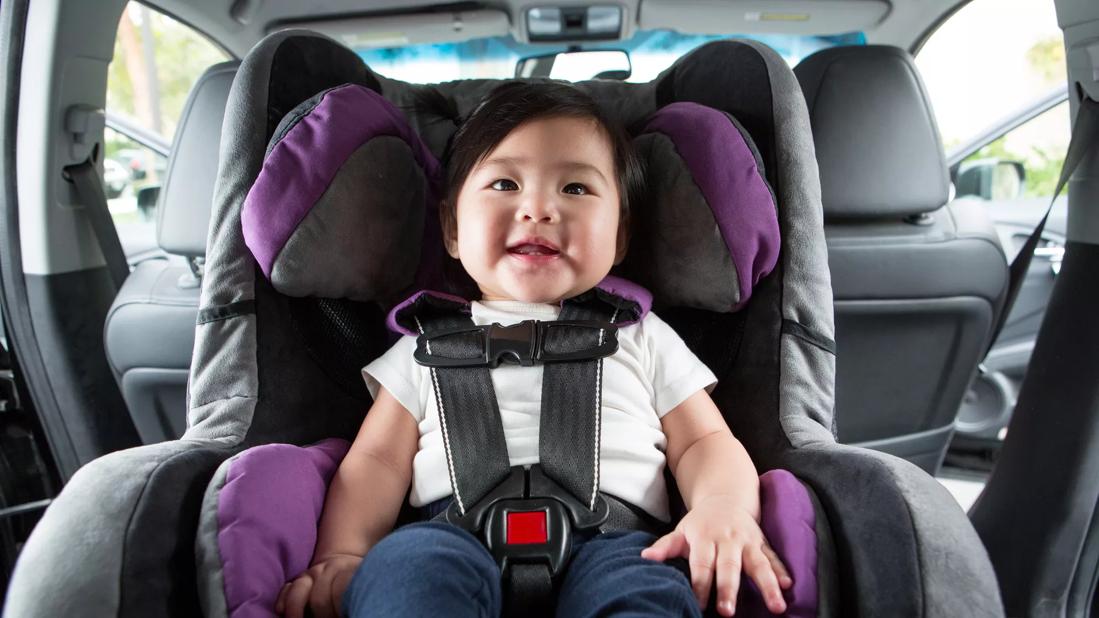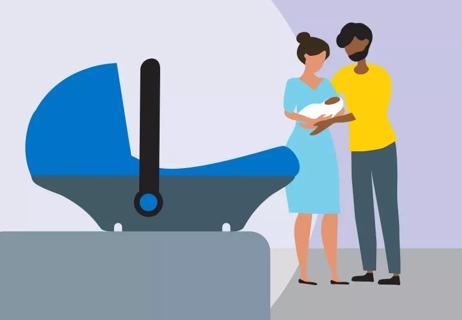Keep your child rear-facing as long and possible, and ensure proper fit and installation

Back in the day, babies and toddlers would be tethered to the back seat of the station wagon without much more than a strap to keep them in place. That’s if they were buckled in at all.
Advertisement
Cleveland Clinic is a non-profit academic medical center. Advertising on our site helps support our mission. We do not endorse non-Cleveland Clinic products or services. Policy
Things really do change.
These days, every state in the United States has laws that require infants to ride in car seats. And those laws commonly require most elementary school-aged children to use a booster seat, too.
While the laws may differ slightly, they’re all intended to keep kids safe in the car.
And they work.
Consider these statistics from the National Safety Council: Between 1976 and 1986 — the year all U.S. states adopted car seat safety laws — more than 14,700 children under the age of 5 died in car crashes. Between 2010 and 2020, that number was closer to 5,400.
Keeping your child safe in the car is important. And there’s a lot to consider: rear-facing, front-facing, carriers, boosters… How do you know what car seat is right for your child? And what car seat safety guidelines do you need to know?
“The best car seat for your child is a matter of safety and reliability,” says pediatrician William Mudd, DO. “It comes down to choosing the right seat, installing it properly and making sure you use it right, every time.”
Dr. Mudd shares the basics of car seat safety so you can be sure your baby (and your big kid) stays safe in the car.
When you’re preparing for a new baby, there’s a lot of gear to consider. And your car seat is one of the most important choices you’ll make.
Advertisement
There are dozens of brands and makes of car seats to choose from. But rest assured that any new car seats you find online or in stores must pass rigorous safety tests in order to be sold.
“Car seat safety is highly regulated in the U.S. All car seats have to meet federal safety standards to be sold legally,” Dr. Mudd explains. “But those standards assume proper installation and fit, so you need to make sure you’re following your manufacturer’s guidelines.”
Again, those safety measures are in place for new car seats, fresh out of the box. Car seats expire. And car seats that have been in a crash can be compromised. So, be vigilant. Whenever possible, you’re best off not using hand-me-downs when it comes to car seats.
“Never use a car seat if you don’t know its full history or a car seat that’s been involved in a crash,” Dr. Mudd advises. “And don’t use a car seat that has passed its expiration date. Generally, that’s about six years, but you can contact the manufacturer to find out what the expiration date is for your specific seat.”
When you pick out baby’s first car seat, you’ll have two basic styles to choose from:
Whatever kind of car seat you choose, it’ll need to be rear-facing as long as possible. That means you’ll want your child to stay facing backward until they reach the maximum weight or height their car seat allows for rear-facing.
“Rear-facing is safest for babies and young toddlers and is legally required in a lot of cases,” Dr. Mudd states. “I advise parents to keep their child rear-facing as long as their car seat weight limit will allow. Switching children to forward-facing too early is, by far, the most common error I hear and see parents make when I discuss this matter at well-child checks.”
Infant carrier car seats are small and have carrying handles. They can only be used rear-facing.
Most models come with a detachable base that can be left in the car. Some also can be used in stroller “systems,” which means you can remove the carrier from the car and place it right on a stroller without having to unbuckle your baby.
“Infant carriers are a popular choice for newborns and infants because they give parents and other caregivers the convenience of being able to take the baby out of the car while keeping them safely buckled in,” Dr. Mudd says. “And infant carriers may fit newborns better than convertible car seats.” Infant carriers are generally the best car seat for babies born preterm (“preemies”).
Advertisement
Dr. Mudd offers these tips for safely using an infant carrier:
Babies commonly fall asleep in their carriers in the car or stroller. That’s OK. But Dr. Mudd says an infant carrier shouldn’t be your baby’s primary sleep space. It’s not safe to allow babies to use an infant carrier for napping or sitting for long stretches. Infants should sleep most safely on flat surfaces.
Advertisement
Also, babies shouldn’t eat or drink in carriers (no propping the bottle in the car seat … or anywhere for that matter). And carriers should never be left on high surfaces, like tables or chairs.
Convertible car seats stay in place in your car.
They can be used in rear-facing mode and switched to face forward as your child grows. Convertible car seats often have higher rear-facing weight limits than infant-only car seats, with some going up to 30 or 40 pounds.
Because they’re so versatile, convertible car seats can be used much longer than an infant carrier-style car seat. But they may not be as convenient. And newborn infants may not fit as well in some convertible car seats.
If you choose a convertible car seat for your infant or your older child, consider these safety tips:
Advertisement
Starting with their first ride in the car, newborns and babies need to be in rear-facing car seats. And they’ll need to use the car seat for every car ride.
When possible, car seats should be installed in the back seat. If your vehicle allows, the middle of the back seat is the ideal position for a baby’s car seat. That may not work well in all vehicles, though. You’ll want to make sure the car seat is secured with appropriate anchors and the seat fits well in its position.
“When it’s possible, the middle back seat location is the best possible choice, but vehicles are all made differently. Some don’t accommodate car seats as well as others in that middle position,” Dr. Mudd notes. “If the middle seat isn’t a good fit, either side of the back seat can be safe, too, as long as the seat is well-secured.”
If your vehicle doesn’t have a back seat, you’ll need to make sure the front passenger seat airbag is turned off. Place the car seat in the middle front seat if your vehicle has side-impact airbags.
Be sure the car seat is buckled securely in the car. If you can move the car seat more than an inch side to side or toward the front of the car, it’s not tight enough. Refer to your instruction manual to use the seat belt or LATCH system to firmly buckle in the car seat or infant carrier base unit.
Dr. Mudd advises against using any products in the car seat that didn’t come from the manufacturer. That includes things like extra cushions around your baby’s head or on the car seat straps. And keep out any add-on toys. Those can injure your child in the event of a crash. If your car seat came with a newborn insert, bring the insert to your hospital room and ask for advice about whether and how to use it.
Remember, too, to remove your child’s puffy winter coat when in the car seat. If it’s cold, use a blanket, or put their coat on top of them backward (with their arms in the armholes), after buckling them into the car seat.
If you have questions about the best car seat for your child or need help installing your car seat, Dr. Mudd advises that most fire departments and hospitals can help. You can also contact a Child Passenger Safety Technician at 1.866.SEAT.CHECK (1.866.732.8243).
Learn more about our editorial process.
Advertisement

Use these precautions to guard against tragedy

Babies born preterm may need special precautions to ride safely in a car

Get the answer along with tips for safe installation

Thousands of head and neck injuries occur every year

How to know when your child’s ready to face front, switch to a booster seat and more

How to keep your little one warm and safe in the car

Jaundice that’s present at birth or lasts more than a week should be evaluated by a pediatrician

There’s more than one way to potty train, but this intensive method can kickstart the process

If you’re feeling short of breath, sleep can be tough — propping yourself up or sleeping on your side may help

If you fear the unknown or find yourself needing reassurance often, you may identify with this attachment style

If you’re looking to boost your gut health, it’s better to get fiber from whole foods